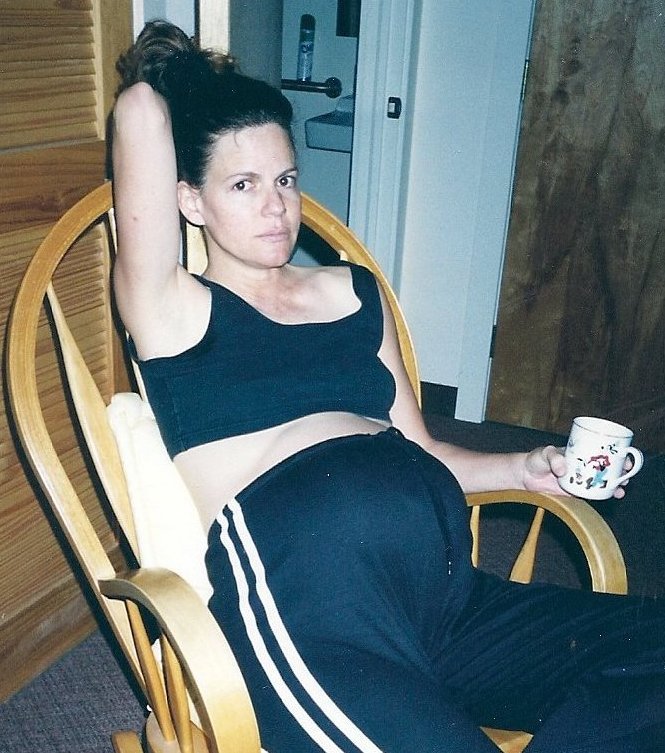
Can grassfed raw milk reduce childbirth pain? While conventional practitioners would poo-poo the idea, the fact is that it is possible with more and more women drinking it regularly and opting for a natural birth in the face of over-medicalization of the birth process.
It is already known that pregnancy diet can play a crucial role in how much childbirth pain a pregnant woman experiences during delivery and whether or not she is successful in withstanding the tremendous physical effort and stamina required to have a natural birth.
So why not raw milk specifically?
The picture above was taken while I was transitioning at 9cm dilation. I was literally minutes from pushing my baby out. Most women in a similar situation are begging for drugs at that point or are already on an epidural IV and completely numb from the waist down.
As for me, I was totally comfortable other than feeling the amazing intensity of the pain free contractions. Here’s my story.
I was fortunate to experience three natural births. The difference between them in the level of discomfort experienced was profound, however, and I can attest that my diet during each of the pregnancies played a key role in the amount of pain I experienced during labor.
During my first pregnancy, I ate completely organic and hormone/steroid free. I ate what would be termed a stellar diet in almost every way. I had a complication-free, natural, and fairly fast delivery although it was a pretty painful experience.
During most of my second pregnancy, I improved my whole organic diet by several notches by adopting a fully Traditional Diet. I took high vitamin cod liver oil and consumed plenty of grassfed meats. I prepared my grain based foods properly by sprouting, soaking and/or sour leavening. My second birth experience was way faster than the first (as is fairly typical for most women), but it wasn’t really that much less painful.
During my third pregnancy, however, I had a Traditional Food available to me in unlimited quantity that I did not have as an option in the previous two pregnancies.
That food was raw, grassfed milk.
I drank raw grassfed milk with abandon with my third pregnancy. It kept my morning sickness at bay during the first trimester due to my propensity for low B6. B6 deficiency can cause morning sickness and raw milk is loaded with this nutrient in highly bioavailable form. B6 supplements did not produce the same excellent results.
Sipping raw milk all day long kept my tummy very happy during those early weeks. Incidentally, pasteurization destroys B6.
What ended up being the most surprising, however, was how completely pain free my third delivery was. The birth of my third child was slower than the second birth, so speed was not a factor.
The picture above is me at 9 cm dilation, completely comfortable and without any discomfort. I told my husband to snap a picture as I couldn’t believe it at the time! I even chatted with my Mom on the phone while I was in transition (she was in the car on her way to the birth center).
Calcium Status Greatly Affects Childbirth Pain
What was the difference? Science will tell you that a women’s calcium status greatly affects the pain she experiences with the uterine contractions during labor.
However, it is much more than just calcium intake as I was consuming plenty of calcium during my first 2 pregnancies and both labors were quite painful as is the norm today. I should note that the calcium was from natural sources too as it was typical for me to drink 1-2 cups of nettle tea during all my pregnancies and nettle is high in calcium and a known uterine tonic. A pain free delivery is not just a matter of popping calcium pills, eating foods that are factory fortified with calcium, or even consuming natural foods high in calcium like nettle.
Why was the delivery of my third child so comfortable and even (gasp!) an enjoyable experience by comparison then?
The bioavailability of the calcium in the diet is an all important consideration that some in the scientific community have not fully grasped yet but a growing number of researchers are emphasizing and certainly something the effects of which I experienced firsthand.
You see, raw grassfed milk is loaded with calcium but it also has something special that pasteurized dairy, calcium supplements, and calcium fortified foods do not.
That something is the enzyme to absorb the calcium!
Voila!
What good is consuming calcium if your body simply does not know what to do with it or can’t do anything with it?
In other words, to experience a comfortable and even pain free labor and delivery requires not just getting enough calcium but getting it in a form that the body can absorb!
To make a long story short, if you think you are getting enough calcium in your diet and you are pregnant, think again. Not all calcium is created equal!
Examine your pregnancy diet and make sure it is loaded with plenty of raw grassfed dairy so that you are getting the bioavailable form of this important nutrient in copious amounts!
Worried about consuming raw dairy while pregnant? Don’t be. Raw grassfed milk is one of the safest foods you can consume and CDC data proves this as shown by the research of Dr. Ted Beals MD.
Interested in following a completely Traditional Diet during your pregnancy and potentially experiencing significantly reduced childbirth pain as a bonus? Here’s an article which outlines the ideal pregnancy diet as recommended by the Weston A. Price Foundation. This is the diet I followed during my second and especially my third pregnancy with the addition of raw grassfed milk.
More Information








Another thing I think is helpful is being strong physically. I was very fit and felt confident I would be in control. Also, check out Tupler technique for strengthening transverse abs- I think it really helps during birthing as well as postpartum. 🙂
never heard of this but will find out if it works for me in may. this is my first and fingers are crossed. 🙂
(I sometimes go through a half gallon of real milk in 24 hours)
I so agree with the milk, fclo and diet! My almost 9# watermelon came out in 2 pushes.
I could not afford a home birth and of course, insurance would not cover it. So, I got to the hospital at 8.5cm, gave birth 30min later without intervention, IV inserts, etc. I DEMANDED it via birth plan and told them to leave me and my husband alone. The doc came in to catch the baby, my husband bathed our daughter and gave her to me. He then accompanied her to get “checked” and make sure she was not stuck with anything while I showered. We left about 16 hours later. It wasn’t my ideal, but I ran the show how I wanted it (which they hate, but oh well, ha!)
I think the key is magnesium, not just Calcium alone.
I can say I had a similar experience. With my first I ate non organic, didn’t drink milk period, ate fast food often (I’m very ashamed to admit this) and my labor was fairly quick but very painful! I did not plan to have a natural birth and was in the hospital with an MD. I thought my lack of preparation and education on how to relax during contractions was what made my labor so excruciating. I was 5 cm when I got my epidural and I honestly couldn’t imagine worse pain prior to my epidural!! After having my daughter we started eating much more healthy and nutritious, including lots of raw dairy. I maintained this diet throughout my second pregnancy and I can honestly say my labor the second time around was not bad at all! I did lots of natural child birth preparation, had a water birth in a birthing center. When people ask how I did it and handled the pain, I almost felt silly saying out loud that it was not bad at all. I was nearly silent the whole time. I started to get truly uncomfortable the 8 minutes I pushed him out. All in all it was the best experience of my life! And I do believe raw milk throughout my pregnancy helped with making my labor close to pain free! 🙂
Wow, I had a great home delivery of my son almost 40 years ago, while living in rural Washington State. We ate lots of fresh home-grown and foraged foods, local oysters right off the beach, and plenty of milk almost right from the cow, from our farm neighbors. We would bring a clean glass gallon jar, and swap it for one that they had just filled in the last hour or two, with the cream already rising to the top.
I’m so glad you explained the picture, because to be honest, it looks like you want to kill someone. Your jaw is set and looks very tense, and your eyes look hard and intense.
I wish I could do this 🙂 anatomically I’m tipped and no baby is ever coming out without a Caesarian. That being said I love raw milk and know it contributes to a healthy baby, mama and speedy recovery. I refuse as much intervention as possible during/after deliveries…no baby bath, no eye drops, no shots, no seclusion from mama, no drugs in my iv for pain management. It’s possible to make it as close to what you want. And my pain is nearly non existent after the surgery.
How do you all find the money to pay for home births? After researching, I found someone who charges $3500 which isn’t bad but with having birth at the hospital, you know your insurance will cover most and you can make payments. I would prefer a home birth but if its not doable financially, then what?
As long as you’re seeing a Certified midwife, you can still keep records and submit your home birth costs to insurance. Most when informed ahead of time will cover up to 60-80%. My midwife is Amish so that’s not an option for us, but after researching, our minimum insurance out of pocket for a standard hospital birth was $2700 and our midwife charges $1700 for all prenatal, delivery and six weeks of postpartum care. Much cheaper and far better care.